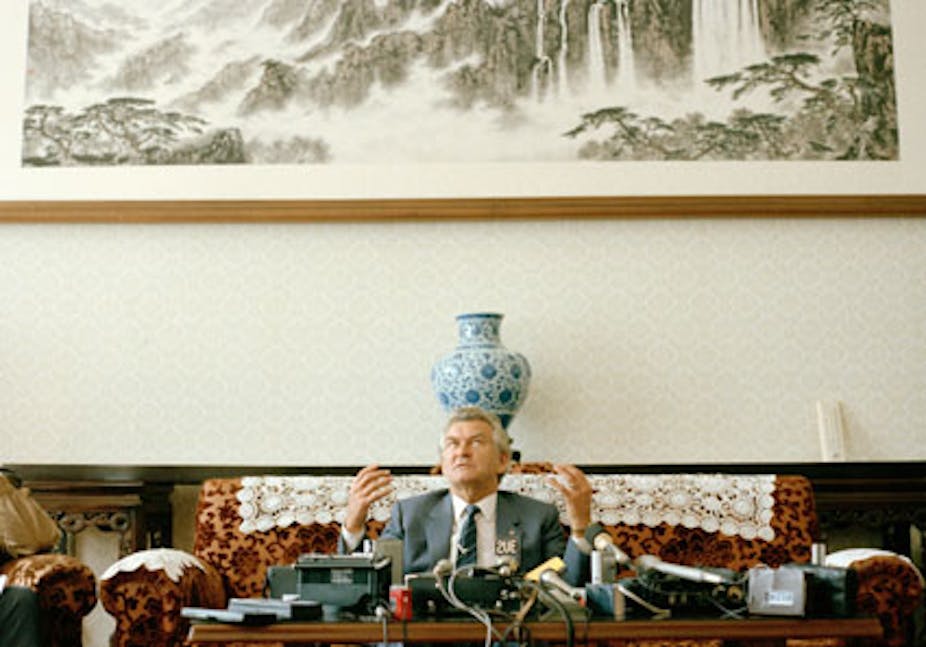The Hawke government in the 1980s is widely considered to be the most competent and effective of recent years. Some may say this is not setting the bar terribly high, but the cabinet papers of 1988-89 demonstrate a degree of coherence about foreign policy that hasn’t always been evident since.
This is not to say that policymakers and advisers in the Hawke era got everything right. On the contrary, India was seen as the long-term potential economic force in the region, rather than China. Likewise, 25 years ago it was Japan that was the regional economic colossus and cabinet discussions reflected this apparently immutable reality.
And yet on the big foreign policy issues, the Hawke government not only looks prescient, but it also displayed a surprising degree of independence of thought at times. The discussions around the formation of what came to be the Asia Pacific Economic Cooperation (APEC) grouping reveal a noteworthy recognition of the possible advantages of a “western Pacific” regional membership that excluded the US and Canada, and which could act as a “third voice” in international trade negotiations.
It is difficult to imagine any recent government even contemplating any policy initiative that didn’t have at least the imprimatur of the US, if not its active participation. APEC’s membership eventually expanded because its other prospective members – especially the all-important Japanese – weren’t interested in any grouping that didn’t include the US and facilitate access to north American markets.
Notwithstanding such diplomatic complexities, the Hawke government’s focus remained steadfastly on facilitating what has now come to be known as “Asian engagement”. While it may be the taken-for-granted orthodoxy among the major political parties and commentators now, it was still very much a work in progress 25 years ago.
Ross Garnaut’s seminal report on the Northeast Asian Ascendancy did more than anything else to give a coherent rationale for greater economic integration with the region. Even if some still question the basis of this engagement and the heavy reliance on supplying resources to a rapidly industrialising neighbourhood, the Garnaut report provided a vital part of an overarching, multi-dimensional plan with which to develop economic activity in Australia.
These days we might call this a “whole of government” approach. While something of a cliché, this phrase does capture the character of the Hawke government’s reformist zeal. Other cabinet papers reveal the thinking behind the structural adjustment policies that would come to be the domestic counterpart to the sort of market-oriented reforms outlined by Garnaut.
Whatever one may think about the wisdom of some of these initiatives 25 years later, what is most striking is that this was plainly a government that had big ideas and ambitions, as well as the people and policies to put them into place. The contrast with recent governments of both political persuasions is striking and illuminating.
Perhaps such confidence and ambition reflected the spirit of a time when the world seemed on the brink of momentous change – possibly, but not inevitably, for the better. 1989 was, after all, the year of wonders – bookended by the crushing of student protest in Tiananmen Square and the fall of the Berlin Wall. As the paper on Australia’s regional security interests rightly observed, Soviet communism had:
… failed to meet the challenges of the contemporary world.
Significantly, even in late 1989, no-one was expecting the Soviet Union’s abrupt demise. By contrast, the cabinet papers were half-right about China. Although the expectation was that China would be the weakest of the world’s great powers, cabinet documents show remarkable prescience in suggesting that trouble may be in store if China pursued a “more aggressive assertion of its territorial rights”. And this is precisely what has happened.
This judgement is all the more remarkable, perhaps, when we remember that policymakers were preoccupied with how to deal with China in the aftermath of Tiananmen Square. This was an event that not only demolished the hopes a generation of democratic activists in China itself, but it also shattered illusions about the triumph of liberal values across the region and the world.

Cabinet advice about how to respond to Tiananmen indicated the sort of pragmatic self-interest that has come to characterise policy across the political spectrum, despite some occasionally lofty rhetoric and posturing at times:
Australia’s response needs to be carefully crafted to walk the fine line between continuing to condemn the leadership’s actions while avoiding unnecessary and enduring damage to our strategic and commercial interests.
Plus ça change? But before we rush to condemn the apparent cynicism in such sentiments, we need to recognise that difficult, unpalatable decisions are a necessary part of being in government. In any case, there are limits to what a country like Australia can do.
Despite the occasional compromises and inevitable misjudgements, the cabinet documents reveal a government that not only had ideas and plans about what it might do while in power, but one that clearly had the capacity to implement them. Perhaps times do change after all.

